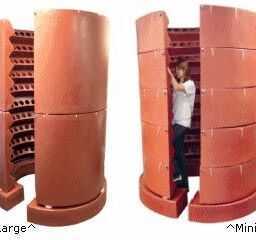A Strange Waltz Around A Blue Ice Giant
Strange things happen in the cold twilight of the outer Solar System. In this faraway region, four gigantic planets entice observers on Earth with their tantalizing treasure trove of delightful, shocking, weird, and wildly wonderful mysteries. The banded, beautiful, and blue ice-giant Neptune is both the most distant giant planet from our Sun, as well as the smallest of the quartet of outer gaseous worlds. But even by the bizarre standards of the outer Solar System, certain oddities stand out in this crowd of oddballs. Such an outstanding oddity is the weird waltz of avoidance performed by the innermost duo of Neptune’s icy moons. In November 2019, astronomers announced that the tiny Neptunian moons, Naiad and Thalassa, are in orbits that carry them only about 1,150 miles from one another–but the two moons never get close enough to dance.
Experts in orbital dynamics refer to this strange performance as a “dance of avoidance”. The two tiny moons are near each other, but nonetheless manage to stay far enough away to avoid a close encounter. This is because Naiad’s orbit is tilted and perfectly timed. Every time this little moon passes the slower-moving Thalassa, the duo are about 2,200 miles apart.
As this strange ballet of the moons is being performed, Naiad twirls around its parent-planet every seven hours. In the meantime, Thalassa’s dance along the outside path takes seven and a half hours. If an Earthling stood on Thalassa, and looked up in wonder at its strange alien sky, it would appear that Naiad’s orbit creates a weird and wild zigzag pattern–passing by twice from above and then twice from below. This rather weird performance occurs over and over again as Naiad acquires four laps on its partner Thalassa.
Although this distant dance may seem bizarre, it serves a definite purpose. It keeps the orbits of the little moons stable.
“We refer to this repeating pattern as a resonance. There are many different types of ‘dances’ that planets, moons and asteroids can follow, but this one has never been seen before,” commented Dr. Marina Brozovic in a November 14, 2019 NASA Jet Propulsion Laboratory (JPL) Press Release. Dr. Brozovic is the lead author of the paper describing this research, which was published November 13, 2019 in the journal Icarus.
In The Distant Domain Of The Giant Planets
In the distant domain of the quartet of giant planets, far from the powerful pull of our Star, the planets themselves are the main sources of gravity. Collectively, the gaseous quartet sports myriad mostly icy moons, and some of those moons were born at the same time as their parent-planet–never migrating away from their place of birth. In contrast, some of the other moons were snared later in their planet’s history, and then became locked into orbits controlled by their parent-planets. Some of these many moons circle opposite to their planet’s direction of rotation, while others exchange orbits with one another as if to avoid a catastrophic smash-up.
The four giant planets of the outer Solar System are Jupiter, Saturn, Uranus, and Neptune. Neptune and Uranus are both classified as ice-giants, while Jupiter and Saturn are classified as gas-giants. The two ice giants are blanketed by thick gaseous atmospheres that are, nevertheless, much thinner than those possessed by the much larger gas-giant duo. Also, Uranus and Neptune contain larger solid cores than Jupiter and Saturn, and they are both smaller in size than the enormous gas-giants.
Galileo Galilei (1564-1642) detected Neptune on December 28, 1612. Galileo used his primitive “spyglass”–one of the first telescopes used for astronomical purposes–to make his discovery of the outermost known giant planet in our Solar System. He again detected Neptune for a second time on January 27, 1613. Unfortunately, on both occasions, Galileo mistook this distant world for a fixed star situated near the planet Jupiter. Because of this unfortunate case of scientific mistaken identity, Galileo is usually not credited with the discovery of Neptune.
NASA’s Voyager 2 spacecraft whizzed past the somewhat larger greenish-blue ice-giant, Uranus, in 1989, sending back to Earth some interesting images of Neptune that revealed a beautiful sapphire-blue-banded world. Those early images of Neptune also showed spot-like whirling storms that were hauntingly similar to hurricanes on Earth. Neptune’s stripes and bands are varying shades of blue, and they formed as the result of atmospheric methane–not oxygen. Some of Neptune’s storms look like swirling white marshmallows.
Voyager 2 also succeeded in being the first spacecraft to detect Neptune’s Great Dark Spot back in 1989. The Great Dark Spot was an anti-cyclonic storm that extended 19,000 X 6,000 kilometers, and astronomers on Earth immediately noticed the resemblance between this distant Neptunian storm and Jupiter’s Great Red Spot. However, several years later, on November 2, 1994, the Hubble Space Telescope (HST) did not detect the Great Dark Spot–which had apparently vanished. Instead, HST discovered a new storm, that was very similar to the Great Dark Spot, in Neptune’s northern hemisphere.
Neptune itself is not visible to the unaided human eye, and it is the only planet in our Solar System to have been discovered by mathematical prediction instead of by direct observation. Unexpected changes in the orbit of Uranus led the French astronomer Alexis Bouvard (1767-1843) to mathematically determine that Uranus’s orbit was being influenced by the gravitational jostling of an undiscovered planet. As a result, Neptune was discovered with a telescope on September 23, 1846 by the German astronomer Johann Galle (1812-1911). Galle discovered Neptune within a degree of the position that had been previously predicted by the French mathematician and astronomer Urbain Le Verrier (1811-1877). Not long after Neptune’s discovery, its largest moon, Triton, was discovered. None of the planet’s remaining known moons were detected telescopically until the 20th century.
Neptune’s distance from our planet makes it appear small in Earth’s sky, and this makes it difficult for astronomers to observe it with Earth-based telescopes. The space telescope HST, along with large telescopes on the ground, recently provided a treasure trove of detailed observations from far away by using the technique of adaptive optics. Adaptive optics is a method that corrects for distortions resulting from temperature, wind, and mechanical stress by deforming a mirror to compensate for this distortion.
Like the other giant gaseous planets dwelling in the outer Solar System, Neptune has many moons and a system of gossamer rings. The rings of Neptune are fragmented and very faint, and are referred to as arcs. The arcs were first discovered in 1982, and were later confirmed by the Voyager 2 spacecraft.
Neptune has 14 known moons. Neso is the farthest Neptunian moon from its parent-planet, and its orbit creates a weird elliptical loop that takes it nearly 46 million miles away from Neptune. Neso takes 27 years to complete a single orbit.
A Bizarre Celestial Waltz
Naiad and Thalassa are very small moon-worlds whose shape has been likened to “Tic Tacs”. Both little moons are only approximately 60 miles in length. As two of Neptune’s seven inner moons, Naiad and Thalassa are members of a heavily populated system that is intricately intermingled with Neptune’s faint arc rings.
How did this strange duo wind up so close and yet so far apart? Astronomers propose that the original system of moons was disrupted when Neptune’s powerful gravitational pull snared its large moon, Triton. As a result the inner moons and rings were born from the relic remnants of debris left in the wake of this ancient calamity.
Triton circles Neptune in the wrong direction. This usually indicates a captured object that was not born in its current position. Triton may be an unhappy wanderer from the Kuiper belt that traveled too close to Neptune’s gravitational embrace, and thus became a moon of one of our Solar System’s major planets. The Kuiper belt is a region beyond Neptune that hosts a population of icy objects of varying sizes, and is considered to be the home of frozen comet nuclei. In the future, Triton’s orbit will likely decay to the point that it plunges into its adopted parent-planet.
“We suspect that Naiad was kicked into its tilted orbit by an earlier interaction with one of Neptune’s other inner moons. Only later, after its orbital tilt was established, could Naiad settle into this unusual resonance with Thalassa,” Dr. Brozovic explained in the November 14, 2019 JPL Press Release.
Dr. Brozovic and her team discovered the weird orbital drama by using analysis of observations made by HST. Their work also provides the first indication about the internal composition of Neptune’s inner moons. The scientists used the observations to compute their mass and, in this way, determine their densities–which were revealed to be similar to that of water ice.
Dr. Mark Showalter, a planetary astronomer at the SETI Institute in Mountain View, California, and a co-author of the paper, told the press that “Naiad and Thalassa have probably been locked together in this configuration for a very long time, because it makes their orbits more stable. They maintain the peace by never getting too close.”
led strip lights
#Strange #Waltz #Blue #Ice #Giant
Will be pleased to have you visit my pages on social networking .
Facebook page here.
Twitter account is here.
Linkedin account here
Post byBedewy for info askme VISIT GAHZLY





